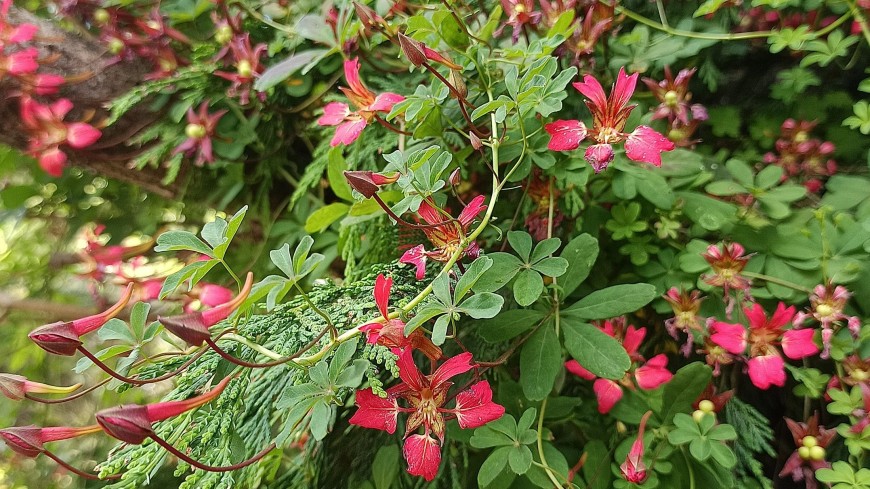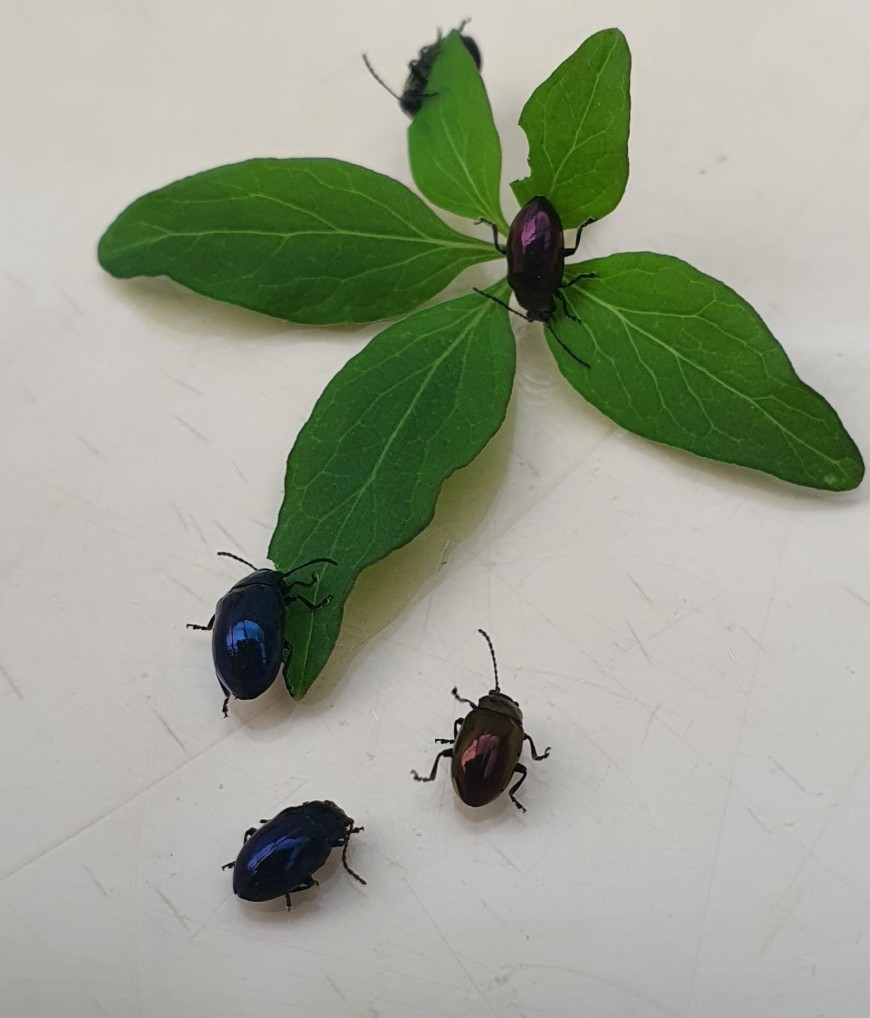Application to release Chilean flame creeper beetle

Image: Chilean flame creeper
Background
The application to release a leaf-feeding chrysomelid beetle, Blaptea elguetai as a biocontrol agent for Chilean flame creeper, Tropaeolum speciosum will be made by Otago Regional Council, representing the National Biocontrol Collective; a consortium of regional councils, unitary authorities and the Department of Conservation. Manaaki Whenua - Landcare Research is the science advisor to the Collective for this application.
Chilean flame creeper is a perennial climber from South America that can grow up to 3 meters high. Plants prefer full sun and will climb to the tops of canopies, covering them to achieve maximum sun exposure. This reduces sunlight for the plants underneath, suppressing their growth and preventing new seedlings from establishing.
Chilean flame creeper is naturalised in parts of New Zealand from Stewart Island / Rakiura to Waikato. It is mainly a problem in Southland, where it suppresses and replaces native species through shading and its smothering growth. Currently only isolated populations are present in the North Island.

Image: Chilean flame creeper beetles.
Identification and assessment of risks, costs and benefits
The potential risks, costs and benefits associated with the proposed introduction of a chrysomelid beetle, Blaptea elguetai to New Zealand and the possible reduction in the abundance and vigour of Chilean flame creeper have been identified by literature review and by consultation with stakeholders.
- Risks, costs and benefits of Chilean flame creeper biocontrol report to come
The application will address in detail the potential significant adverse and the beneficial effects identified (highlighted in bold). The potential benefits of biological control will be the mitigation of the adverse effects of Chilean flame creeper on the New Zealand environment. The key potential adverse effects relate to impacts on native flora and fauna. These will be addressed fully in the application:
- direct damage to native plants
- direct damage to garden ornamentals and crop plants
- indirect effects on flora and fauna as a result of disruption of ecological relationships
Chilean flame creeper, Tropaeolum speciosum Poeppig & Endl., also known as flame flower and flame nasturtium, is a member of the Tropaeolaceae, a family of prostrate or climbing herbs comprising three genera: Tropheastrum (1 species, endemic to Patagonia), Magallana (2 species, endemic to Patagonia) and Tropaeolum (86 species ranging from southernmost Mexico to Chile and Argentina) (Sparre & Andersson 1991). The genus Tropaeolum is subdivided into two sections, T. section Tropaeolum, the species of which are distributed through the American tropics, and T. section Chilensia, which contains 22 species and 6 subspecies distributed in temperate South America, primarily in Chile (Andersson & Andersson 2000; Hershkovitz et al. 2006).
There are no indigenous genera or species in the Tropaeolaceae in New Zealand but three members of the genus Tropaeolum have naturalised: T. majus L. (garden nasturtium), T. pentaphyllum Lam. (ladies' legs), and T. speciosum (Chilean flame creeper) (Webb et al. 1988; Ngā Tipu o Aotearoa - New Zealand Plants Database, accessed via http://nzflora.landcareresearch.co.nz/)._T. pentaphyllum has been placed, along with Chilean flame creeper, in T. section Chilensia. Both these species originate from the more temperate regions of South America. T. majus, on the other hand, is in T. section Tropaeolum, and is thought to have arisen as a spontaneous hybrid in Peru (Sparre & Andersson 1991).
T. pentaphyllum, not commonly grown in cultivation, is mainly grown in the North Island (Webb et al. 1988). Its vegetative parts can easily be confused with those of Chilean flame creeper but the flowers can be readily distinguished. T. majus, the garden nasturtium is very commonly cultivated with many cultivars (Webb et al. 1988). A number of varieties of Tropaeolum are sold through the nursery industry in New Zealand. There are 27 listings under Tropaeolum in Gaddum's Plantfinder 2000 (Gaddum 1990). These appear to be mostly varieties of T. majus, although possibly other species are used (listed as 'pentaphyllum’, ‘perigrinum', and 'tricolorum' in Gaddum's Plantfinder 2000).
Because the Chilean flame creeper beetle is host specific to plants in the genus Tropaeolum and rely on these host plants for development of their larvae to adults, population densities capable of interacting significantly with other plants or animals will only be found in close proximity to Chilean flame creeper and other closely related species (none of which are native). Mechanisms for interaction will be limited. As a result, no significant disturbance of ecological relationships is expected in New Zealand from the introduction of this biocontrol agent.
Pre-application consultation with Iwi
The members of Te Herenga, the EPA's national network, will be contacted and invited to enter dialogue on plans to apply to the EPA to introduce a biocontrol agent for Chilean flame creeper.
The message to Te Herenga will describe how the applicant intends to assess the risks, costs and benefits associated with the proposed introduction. Members will be invited to identify any issues that they would like to be addressed in the application. Further consultation will be undertaken by Otago Regional Council and Manaaki Whenua - Landcare Research.
At the request of the applicant, the EPA convened a reference group from Te Herenga to meet and discuss the issues surrounding the proposed applications. The application will address principles identified in that report.
Pre-application consultation with other organisations
Other organisations that will be consulted in the course of preparing this application include:
- Regional Councils
- Royal Forest and Bird Protection Society of New Zealand
- Department of Conservation
- QEII National Trust
- NZ Landcare Trust
- NZ Entomological Society
- NZ Plant Protection Society
Key documents
Report on host-range determination
Safety issues are paramount to the development of biocontrol for weeds. Researchers rigorously test all proposed agents to assess the risk of damage to non-target plants. A set of procedures helps researchers choose a suitable shortlist of test plants, and this methodology is now well-accepted internationally (Wapshere, 1974). The technique is under constant review to update best practice (e.g. Sheppard et al., 2005; Briese, 2005).
- Report on range determination to come.
Cited references
Andersson L, Andersson S 2000. A molecular phylogeny of Tropaeolaceae and its systematic implications. Taxon 49: 721-736.
Briese D 2005. Translating host-specificity test results into the real world: The need to harmonize the yin and yang of current testing procedures. Biological Control 35: 208–214.
Gaddum M 1999. Gaddum's Plant Finder 2000. New Zealand, Gisborne, New Zealand Plant Finder.
Hershkovitz MA, Hernández-Pellicer CC, Arroyo MTK 2006. Ribosomal DNA evidence for the diversification of Tropaeolum sect. Chilensia (Tropaeolaceae). Plant Systematics and Evolution. DOI 10.1007/s00606-006-0428-7.
Sheppard AW, Heard TA, van Klinken RD 2005. Scientific advances in the analysis of direct risks of weed biological control agents to non-target plants. Biological Control 35: 215–226.
Sparre B, Andersson L 1991. A taxonomic revision of the Tropaeolaceae. Opera Botanica 108: 1–139.
Wapshere AJ. 1974. A strategy for evaluating the safety or organisms for biological weed control. Annals of Applied Biology 77: 201–211.
Webb CJ, Sykes WR, Garnock-Jones PJ 1988. Flora of New Zealand Vol. IV: Naturalised Pteridophytes, Gymnosperms, Dicotyledons. Botany Divison, DSIR, Christchurch, New Zealand.
Key contact
